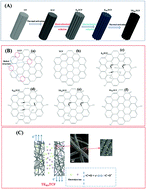Activation of carbon fiber for enhancing electrochemical performance†
Abstract
Carbon fiber (CF) sequentially undergoes thermal activation (TCF), electrochemical oxidation activation (EOTCF), electrochemical reduction activation (EROTCF) and a secondary thermal activation process to form a highly activated CF (TEROTCF) electrode material. EOTCF undergoes a thermal activation process to form TEOTCF. EROTCF, TEOTCF and TEROTCF show specific capacitance values of 1455, 1438 and 1426 mF cm−2 at 1 mA cm−2 and capacitance retention values of 0.97%, 35.62%, and 59.61% when the current density increases from 1 to 20 mA cm−2. EROTCF, TEOTCF and TEROTCF show similar capacitance values, but much superior to CF (709 mF cm−2). TEROTCF shows much higher rate capability than EROTCF and TEOTCF. Carbonyl, epoxy and hydroxyl groups are introduced on the TCF by electrochemical oxidation activation. Carbonyl groups existing at the edge of the basal plane contribute towards improving the specific capacitance of CF. Hydroxyl and epoxy groups on the basal plane of the carbon skeleton lead to the destruction of the conjugated system. The electrochemical reduction and secondary thermal activation cause the removal of the non-electroactive epoxy and hydroxyl groups for recovering the sp2 structure, accordingly enhancing the rate capability of CF. All-solid-state flexible supercapacitors using two TEROTCF electrodes achieve 26.0 μW h cm−2 at 125.0 μW cm−2 and good cycling performance. So, CF with thermal and electrochemical activation treatment shows highly enhanced capacitance for high-performance supercapacitor application.



 Please wait while we load your content...
Please wait while we load your content...